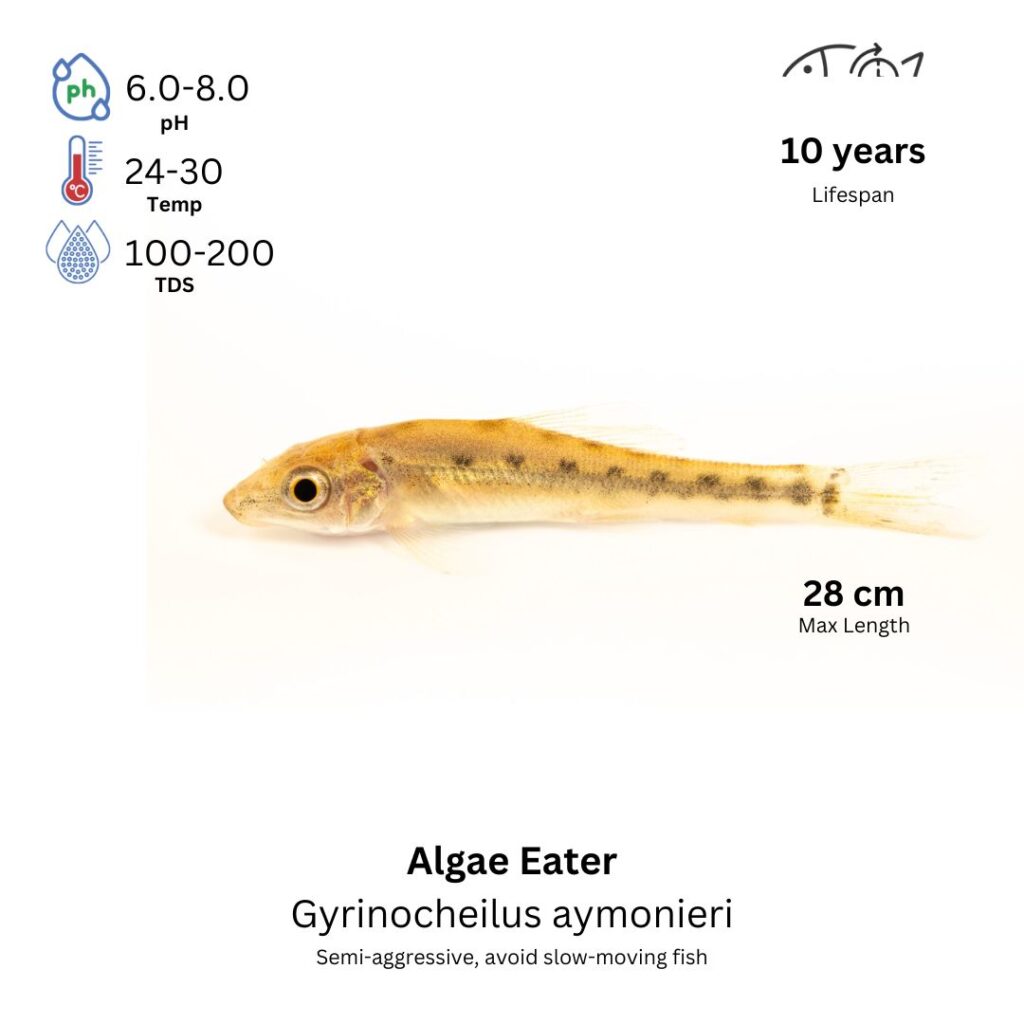Algae Eater
Gyrinocheilus aymonieri

Description
The Algae Eater is a popular species often used for controlling algae growth in aquariums. The most well-known algae eater is the Chinese Algae Eater (Gyrinocheilus aymonieri), which is slender, elongated, and usually has a pale golden-brown to light green body with a dark horizontal stripe running from head to tail. They have a specialized, sucker-like mouth that allows them to cling to surfaces while feeding on algae, biofilm, and detritus. Their behavior is peaceful, but they can sometimes be territorial, especially as they mature, and may become aggressive toward other bottom dwellers or smaller fish.
Habitat Origin
Native to the freshwater rivers and streams of Southeast Asia, particularly in Thailand, Cambodia, and Vietnam. These fish are typically found in fast-moving, well-oxygenated waters with plenty of submerged rocks, plants, and other surfaces to graze on algae. In the wild, they play a key role in keeping their environment clean by feeding on algae and organic matter.
Aquarium
Ideal Number in Aquarium: Typically kept alone, although some can be housed with other peaceful fish that are not bottom-dwelling.
Favorite Food

While they are primarily herbivores, Algae Eaters will graze on a variety of foods. They feed on algae, biofilm, and organic detritus, which they scrape off surfaces in the aquarium. In captivity, they can be fed a variety of foods such as algae wafers, spirulina-based food, blanched vegetables (like zucchini and spinach), and occasional live or frozen foods like brine shrimp or bloodworms. Providing algae-rich food will help keep them healthy and satisfied.
Behavior:
Algae Eaters are generally peaceful, but they can sometimes become territorial, especially as they mature. When kept in smaller tanks, they may become more aggressive toward other bottom-dwelling species, especially during feeding times. They are often active during the day, constantly moving around the tank, grazing on surfaces for algae and organic matter. While they help keep the tank clean by consuming algae, they should not be relied upon as the sole method of algae control. They can also be quite active swimmers, often seen clinging to rocks or decorations with their sucker-like mouths.
Special Care:
Algae Eaters require a tank with plenty of surfaces for grazing, such as rocks, plants, or decorations that are covered with algae. They thrive in well-oxygenated water, and strong filtration is recommended. Regular water changes and a stable tank environment will help keep them healthy. They can be sensitive to poor water quality, so it’s important to maintain clean water and avoid overfeeding. Some Algae Eaters may develop a preference for eating more than just algae, so it’s essential to provide a varied diet, including algae wafers and plant-based foods, to prevent them from becoming too reliant on algae alone.
Compatibility with Other Fish:
Algae Eaters can be kept with other peaceful species, especially those that are not bottom-dwelling. However, they may become territorial or aggressive toward other bottom feeders or similar-sized fish, so it’s best to avoid housing them with other species that occupy the same space. They are generally compatible with community fish such as tetras, rasboras, and small cichlids. It’s important to ensure that the tank is large enough to accommodate their active nature.
Breeding Setup
It is highly recommended to use a separate breeding tank for Siamese Algae Eaters to ensure stable water parameters and avoid disturbances from other fish. A 40-liter (10-gallon) tank provides enough room for breeding activity while maintaining manageable water quality. The ideal water conditions include a pH of 6.5–7.5, temperature between 24°C and 28°C, and water hardness of 4–15 dGH. A gentle sponge filter or low-flow internal filter is ideal to prevent disturbance of eggs and reduce stress. Use fine gravel or sand substrate, and include live plants like Java fern and Anubias, as well as driftwood and rocks to create natural hiding places and surfaces for eggs.
Conditioning for Breeding
Siamese Algae Eaters are omnivores and should be fed a balanced diet of high-quality algae wafers, protein-rich pellets, and live foods such as brine shrimp and bloodworms to prepare for breeding. This diet promotes strong immunity and egg development. Perform weekly 25% water changes using dechlorinated water to maintain clean and stable conditions. Good nutrition and clean water play a vital role in stimulating breeding behavior and ensuring a healthy spawning event.
Spawning Process
Spawning usually takes place early in the morning or in the evening. Males court females by chasing them around the tank. Once ready, the female will lay 100–200 adhesive eggs, typically on plant leaves, rocks, or tank glass. To prevent egg predation, remove the adults immediately after spawning. Siamese Algae Eaters can consume their own eggs or fry, so isolating the eggs is crucial for successful hatching.
Fry Care
Eggs hatch in about 24–48 hours, depending on water temperature. Initially, the fry absorb nutrients from their yolk sacs before becoming free-swimming. At this point, start feeding them infusoria, liquid fry food, or microscopic algae. As they grow, gradually introduce baby brine shrimp or finely crushed algae wafers. Maintain optimal water quality with small daily water changes (10–15%), and keep the water temperature stable between 24–28°C. Regular monitoring of ammonia, nitrite, and nitrate levels is essential to protect the sensitive fry.
Key Considerations
Siamese Algae Eaters reach sexual maturity at about 6–12 months of age. Males are slimmer and more colorful, especially when displaying courtship behavior, while females are larger and rounder, especially when gravid. To ensure successful breeding, minimize stress by avoiding rapid changes in water conditions, preventing overcrowding, and maintaining a quiet, stable environment. With proper care, this species can successfully breed and raise healthy fry in a controlled tank setup.
